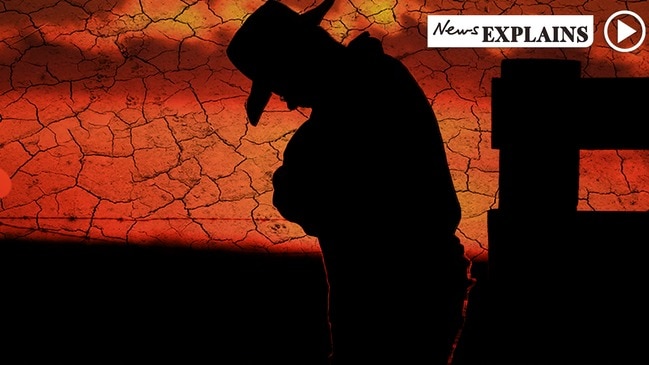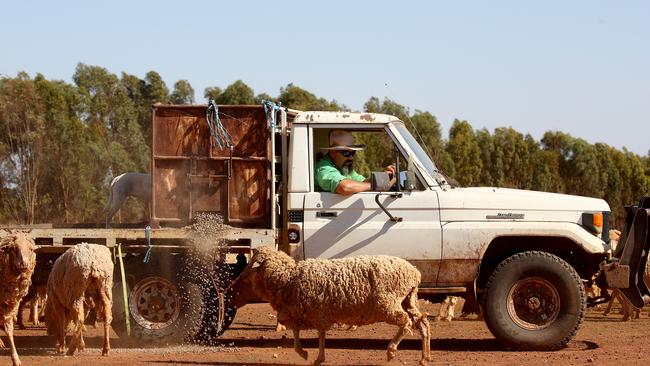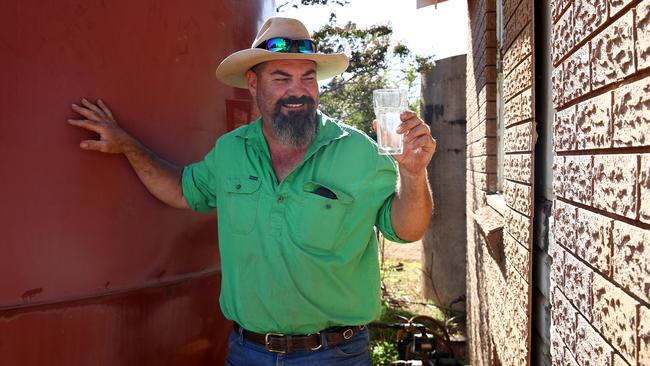Drought: rain is only the first step on the long road to recovery
The NSW coast has been drenched but inland, farmers still need more rain – and financial support, reports Clare Armstrong.

Opinion
Don't miss out on the headlines from Opinion. Followed categories will be added to My News.
After years of endless dust storms, empty paddocks and backbreaking farm work, there’s a glimmer of green hope in regional NSW – but just don’t call it drought-breaking.
Much of the flooding rain that drenched Sydney and doused destructive megablazes on the south coast have barely registered in vast parts of the state.

Even as the first rains fell over the NSW interior and jubilant farmers filmed themselves dancing in the muddy puddles, no one on the ground was close to declaring this drought – the longest in living memory – as over.
In central west NSW, there has been some relief.
Kangaroos hover at the side of the road to eat the new green shoots, while cattle and sheep, once consigned to huddle around a pile of dry hay or feed, are spread across vast paddocks now blanketed in grass.
Some lucky farmers have moved from spending hours a day feeding stock from the back of a ute, to sitting on a tractor instead, preparing a field for a crop.
But in a best-case scenario with consistent follow-up rainfall, a good harvest, calving or lambing season, none of these farmers will see a cent in their bank account for a year.
New England Nationals MP Barnaby Joyce summarises it succinctly. “Water and soil create grass, grass is converted into protein in sheep and cattle, stock is sold in the saleyard and only then can a farmer make their bank manager happy,” he says.
“And that doesn’t happen overnight.”

Ballimore farmer Geoff Frankham delivers a much more blunt assessment.
“It doesn’t rain money,” he laments.
In December, Mr Frankham and his wife Margaret received a delivery of free drinking water to top up the dwindling tank at their house.
“A life saver just before Christmas,” Ms Frankham said.
Organised by volunteers from veteran charity Team Rubicon Australia, the delivery was one of more than 900 carried out across the state under the “Litres for Land” charity program funded by Clubs NSW.
“We were getting so low on water and then out of the blue we were contacted by Team Rubicon, who came in and saved the day,” Mr Frankham said.
Not giving up hope
The couple’s 2000-hectare sheep property was lucky enough to get enough rain to fill up all the dams at the end of January, but they’re under no illusion about the reality of their situation.
“We can’t kid ourselves the drought is over,” Mr Frankham said.
“It looks a bit better, which gives you some hope, but we’re not out of this.”
Tomingley farmer Phil Clark has spent more than $220,000 feeding his sheep through the drought, and while the rain has greened up his paddocks, he’s nowhere near earning that money back.
“Just because it rains, people think it’s all right again, but it will take years for everyone to turn this around,” he said.

Mr Clark – who became a grandfather for the first time earlier this month – also received a water donation through Litres for Land.
A charitable gesture he described as “incredibly humbling”.
“When you’re battling constant dust storms, feeding every day, it’s just a nice morale boost for the family to get that water donated, and it also means that money I’ve saved can be put into the farm business,” he said.
Further west in Tottenham – a small town of about 600 people located in the exact centre of NSW – residents are doing it tough.
Knowing they’re not alone
About 95 per cent of the town’s workforce is in agriculture, and after four years of little to no rain, the community is on its knees. When the water delivery truck rolls in with water for the local bowls club – one of the last social hubs in the town – locals can’t contain their excitement.
“It’s knowing that someone out there is thinking about us and trying to help,” club secretary manager Kelly Anderson said.

Everyone is all too aware of the high cost of this drought.
A fuel attendant at the nearby town of Albert, is matter-of-fact as she reels off the eye-watering debts racked up by neighbouring farmers.
“One guy around here has spent $6 million feeding his sheep because they’re a special breed and he doesn’t want to sell them as he may never get them back,” she said.
“Everyone around here is spending thousands on feed still and a sprinkle of rain isn’t going to stop that.”
Driving into Trundle – a town of just 300 people – the cruel reality of a storm system is brought into sharp relief.
North of the town a sudden downpour caused flash flooding so severe the ballast and heavy wood sleepers supporting the rail line had completely washed away.
Meanwhile a few kilometres south of the town centre, farmers were left to despair at the still-empty dams they woke up to the next day.
Everywhere, recipients of the Litres for Land water donations are singing the program’s praises.
Farmer Henry Pallett has a small cattle property between Walcha and Niangala in the state’s north and said the limited paperwork required to apply for a free water delivery to fill his house’s tanks was the program’s greatest appeal.
“No one’s got five hours to fill out 17 pages when you’re feeding all day … but this program was quick and easy, I think it barely took half an hour,” he said.
It’s no accident the system is easy for farmers to access – it’s by design.

Team Rubicon’s Kyran Byrne has been tasked with the mammoth job of determining how and where NSW Clubs’ $1 million should be spent to ensure critical water is getting to those who need it most. He said making the system as easy to access as possible was a crucial part of its success, and he would often go back to his IT staff and ask them to take out unnecessary questions in the application.
“If you can give me your address and phone number and answer when I call then that's enough,” he explained during a recent water delivery to a community-owned bowls club in Tottenham.
The system set up by Team Rubicon also means that local truck owners can earn some much-needed off farm income carting water to needy recipients.
Using local knowledge to vet recipients has proved a successful formula for many other popular charitable programs. Rural Aid’s Buy a Bale – donating hay to farmers – and grocery drops co-ordinated by Country Women’s Associations across NSW also operate on this basis.
The federal government could learn something from these minimally resourced outfits managing to help out thousands of people.

As farmers now agonise over if and when to try and plant a crop that will survive to harvest and finally bring in some income, not one dollar of the federal government’s flagship $5 billion Drought Future Fund has left Treasury.
The government’s drought response centrepiece hasn’t helped a single farmer. Instead it’s been left to local communities to co-ordinate charity to keep towns and farmers going.
For years politicians have parroted the overused line that “it will rain again”. And of course they were right.
But now that the storms have started, farmers will need all the help they can to survive 12 months of planting, feeding and producing until it finally starts raining money again.

